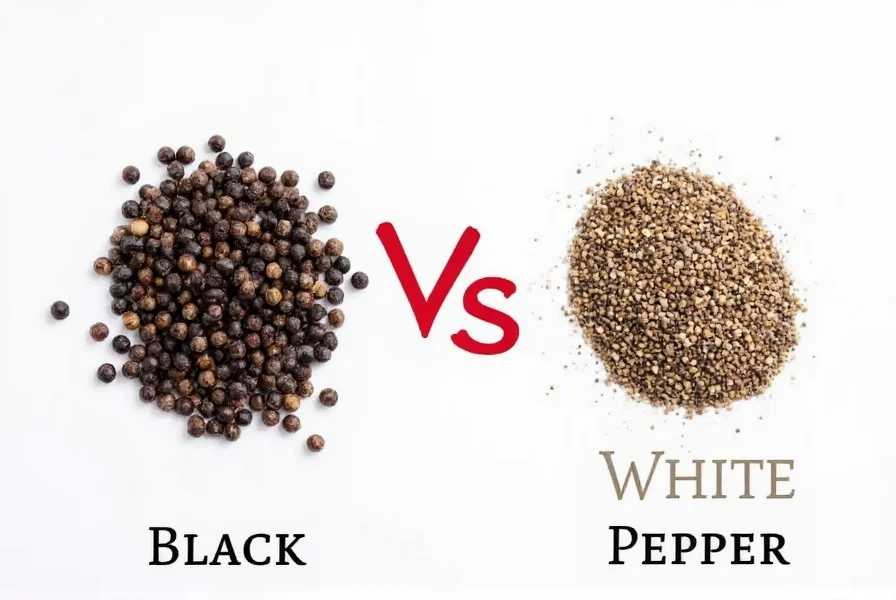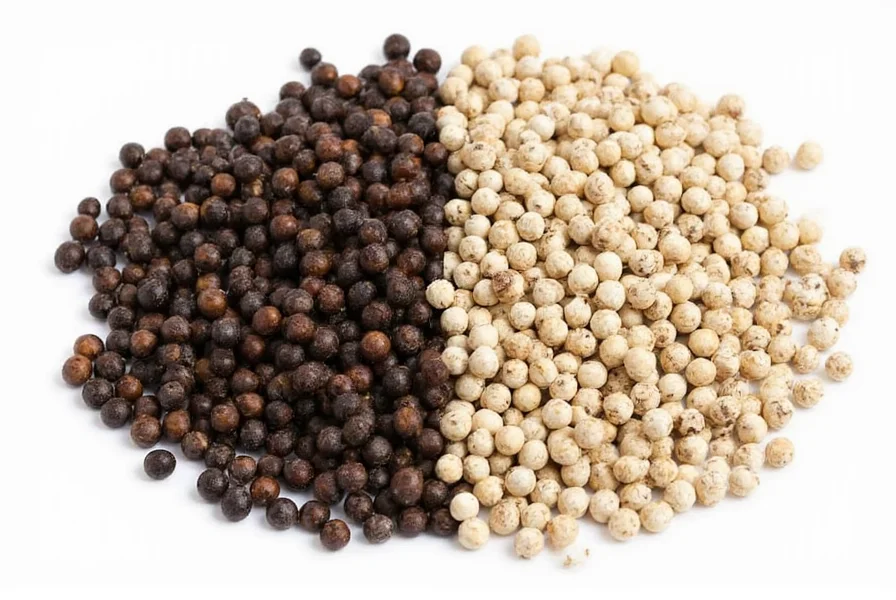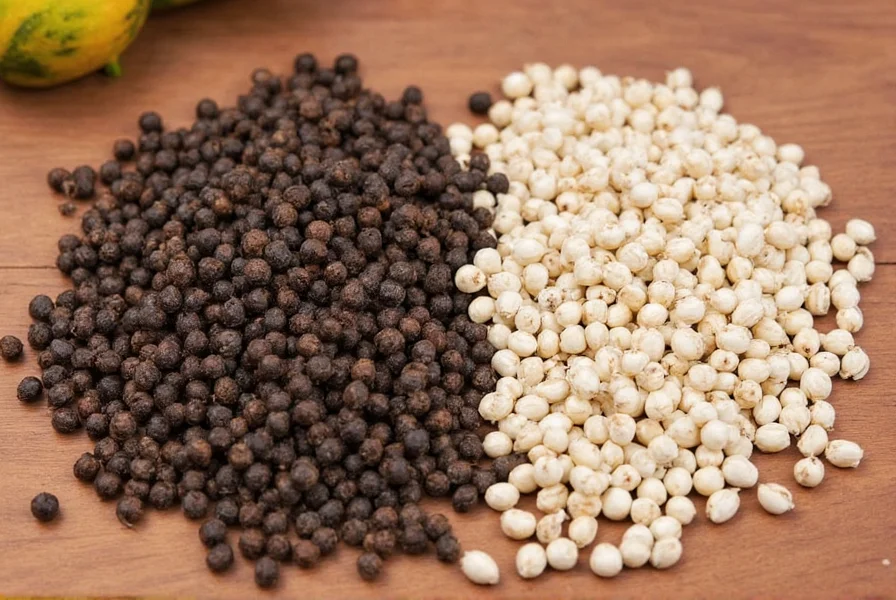The distinction between black and white pepper isn't about different plants or origins—it's all about processing methods that create distinct flavor profiles and culinary applications. Understanding these differences helps home cooks and professional chefs make informed seasoning choices.
Origins and Production Methods
Both varieties originate from the Piper nigrum vine, native to South India but now cultivated worldwide in tropical regions. The critical difference emerges during harvesting and processing:
- Black pepper: Berries are picked when nearly ripe (green to yellow), then sun-dried. During drying, the outer layer (pericarp) turns dark brown or black through enzymatic oxidation.
- White pepper: Fully ripe red berries are soaked in water for about a week, fermenting the outer layer which is then removed, leaving only the inner seed. The seeds are then dried to a pale color.
| Characteristic | Black Pepper | White Pepper |
|---|---|---|
| Harvest Stage | Nearly ripe (green) | Fully ripe (red) |
| Processing | Sun-dried with outer layer | Soaked, outer layer removed |
| Flavor Profile | Sharp, pungent, complex | Milder, earthy, musty |
| Heat Level | Higher (40-50% more piperine) | Moderate |
| Common Culinary Uses | General seasoning, visible specks | Light-colored dishes, sauces |
Flavor and Aroma Differences
Black pepper delivers a more complex flavor profile with citrusy, floral, and woody notes alongside its characteristic heat. The outer layer contains essential oils that contribute to this complexity. White pepper, lacking this outer layer, has a more singular earthy, musty flavor with less pronounced heat.
Professional chefs often describe black pepper as having "brighter" heat while white pepper provides "deeper" warmth. This distinction becomes particularly important when considering which pepper works best for specific dishes.

Culinary Applications and When to Choose Each
The choice between black and white pepper isn't merely preference—it serves specific culinary purposes:
- Black pepper works well in most savory dishes where visible specks aren't problematic—steaks, roasted vegetables, dark sauces, and spice rubs. Its robust flavor stands up to high-heat cooking.
- White pepper shines in light-colored preparations where black specks would be visually disruptive—cream sauces, mashed potatoes, light soups, and fish dishes. French and Chinese cuisines frequently use white pepper for this reason.
Some professional kitchens maintain both varieties specifically for visual presentation considerations. In classic béchamel sauce, for instance, white pepper preserves the sauce's pristine appearance while still providing seasoning.
Nutritional and Chemical Composition
Both peppers contain piperine, the compound responsible for pepper's heat and potential health benefits including enhanced nutrient absorption. However, black pepper contains approximately 40-50% more piperine than white pepper due to the retention of the outer layer.
Black pepper also contains additional volatile oils and antioxidants from the pericarp that white pepper lacks. While these differences exist, the nutritional impact in typical culinary usage remains minimal—both varieties offer similar health properties in normal consumption amounts.

Storage and Freshness Considerations
For maximum flavor, store both pepper varieties in airtight containers away from light and heat. Whole peppercorns maintain freshness significantly longer than pre-ground versions—up to 2-3 years versus 4-6 months.
Grind peppercorns immediately before use whenever possible. The essential oils that contribute to pepper's complex flavor dissipate quickly after grinding. Many culinary professionals recommend using a burr grinder rather than a blade grinder for more consistent particle size and better flavor release.
Common Misconceptions Clarified
Several myths persist about pepper varieties. White pepper isn't "stronger" than black pepper—quite the opposite, it's milder. The notion that white pepper is "more refined" stems from historical European culinary traditions rather than any inherent quality difference.
Neither variety is inherently "better"—they serve different culinary purposes. Professional chefs select based on the specific dish requirements rather than considering one superior to the other.
Frequently Asked Questions
Can I substitute white pepper for black pepper in recipes?
Yes, you can substitute white pepper for black pepper at a 1:1 ratio, but expect flavor differences. White pepper has a milder, earthier taste without the citrus notes of black pepper. It works best in light-colored dishes where black specks would be undesirable, but may lack the complexity black pepper provides in robust dishes.
Why do some recipes specifically call for white pepper?
Recipes specify white pepper primarily for visual reasons in light-colored dishes like cream sauces, mashed potatoes, or chicken dishes where black specks would be visually disruptive. Some cuisines, particularly French and Chinese, traditionally use white pepper for its distinct earthy flavor profile that complements certain ingredients better than black pepper.
Which pepper has more health benefits?
Black pepper contains slightly more piperine (40-50% more) and additional antioxidants from the outer layer, potentially offering marginally greater health benefits. Both varieties enhance nutrient absorption, particularly of turmeric's curcumin. However, in typical culinary usage amounts, the practical health difference between them is minimal.
Does the heat level differ between black and white pepper?
Yes, black pepper generally delivers more heat than white pepper. The outer layer of black peppercorns contains higher concentrations of piperine, the compound responsible for pepper's heat. White pepper provides a more moderate warmth with earthier notes rather than sharp heat.











 浙公网安备
33010002000092号
浙公网安备
33010002000092号 浙B2-20120091-4
浙B2-20120091-4